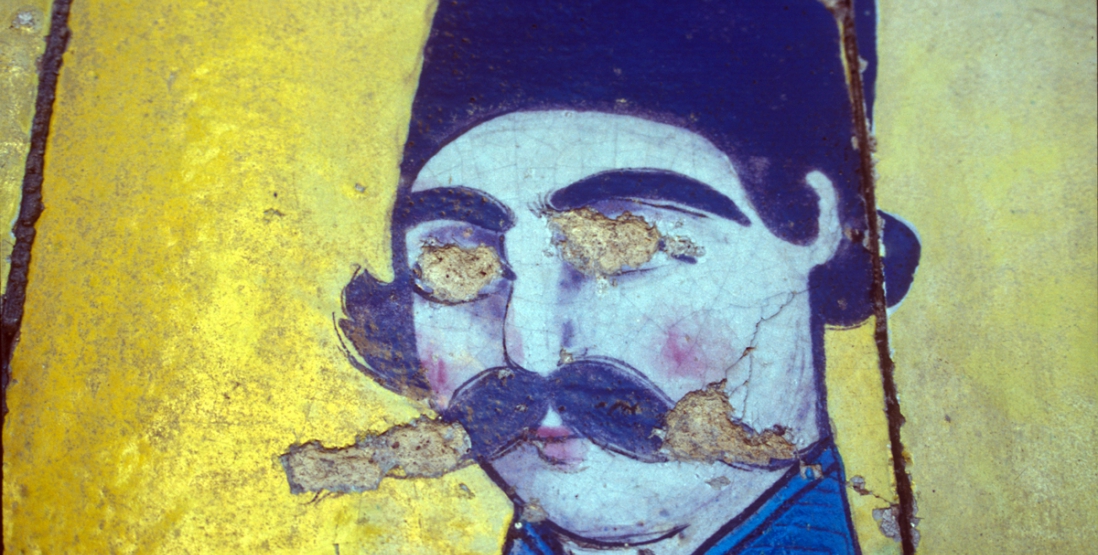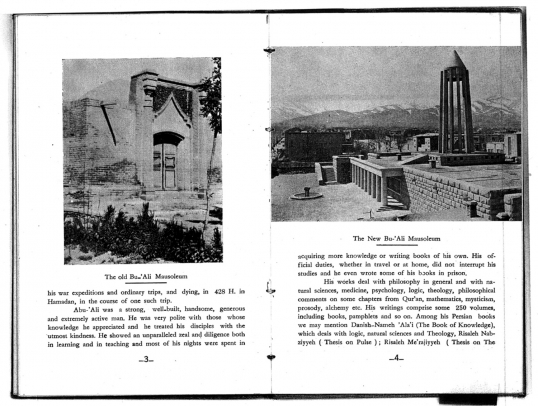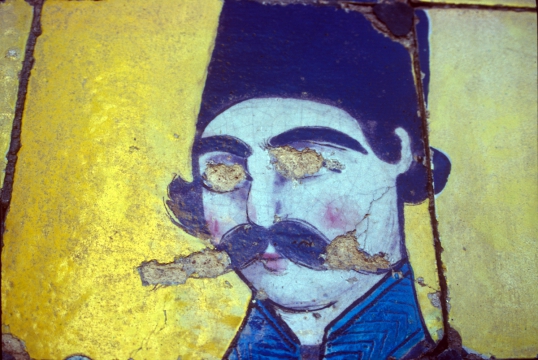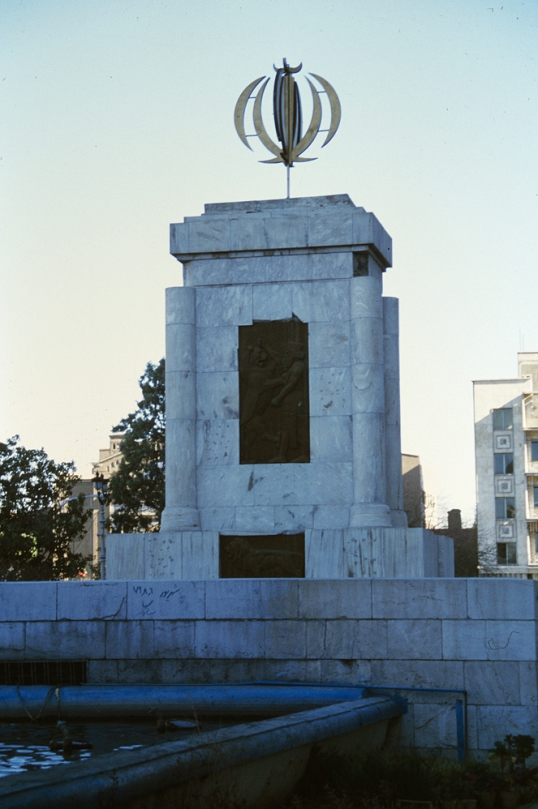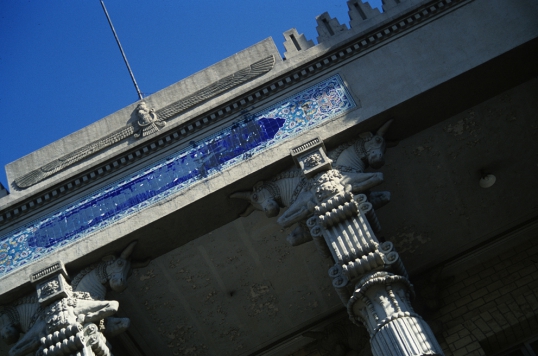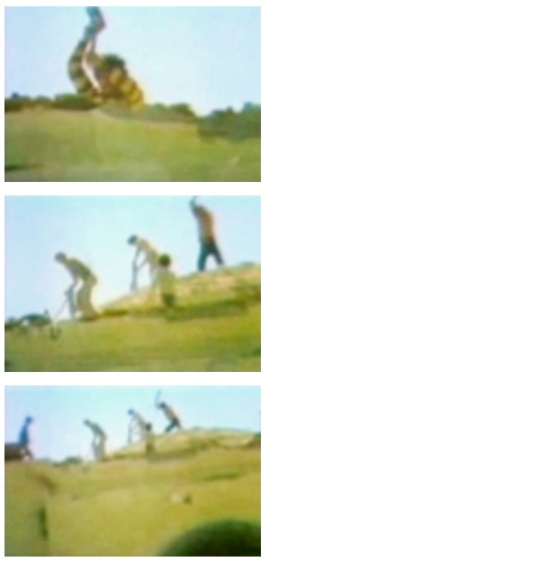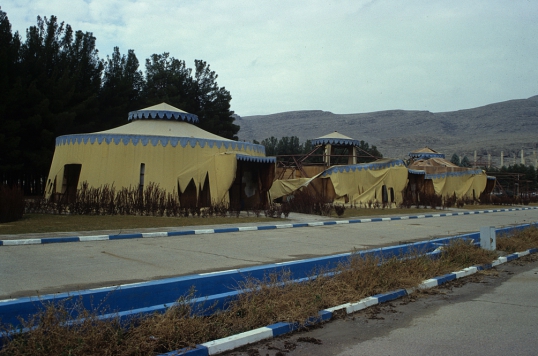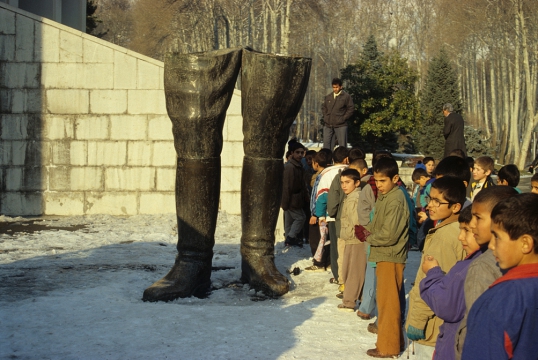The Thing We Love(d): Little Girls, Inanimate Objects, and the Violence of a System
Fig. 2. Detail of the vandalized tile-work of a Qajar courtier, Golestan Palace, Tehran, Iran, late nineteenth century.
Photograph by Talinn Grigor, 2007.The history of cultural destruction in modern Iran is, by and large, syndromatic of its top-down modernizing impulse. With a few exceptions, it has rarely witnessed a systematic destruction of its cultural heritage in the hands of fundamentalists, despite a turbulent twentieth century political history. However, like most modernizing agendas around the globe in the early twentieth century, in Iran, the process of modernization from top-down underpinned the impulse to destroy the old in order to give birth to a new, modern Iran. Reza Shah’s court minister’s 1927 comment to the British secretary that “Persia, after 20 years of so-called Constitutional Government, had made little progress. Everything had to be started over again…” is telling of this impulse.1 The Pahlavi “progress along modern lines” was conditioned by the erasure of the past—a deep desire to change and start over again. The realization of a tabula rasa, a utopian blank slate upon which a new Iran could be conceived, was endemic to the strategies of late Qajar (1868–1905) and early Pahlavi (1925–1941) modernization. Buildings and cities were the first to be affected by this desire for change. The eradication of historical structures and urban pockets meant that a newly built environment could emerge free from the burden of history, geography, and colonialism.
Tehran was the symbol of this particular conception of progress. Between 1932 and 1937, Naser al-Din Shah’s 1868 octagonal fortifications and gates—proposed by the king’s grand vizier Mostowfi al-Mamalek, his minister of the capital Mirza Isa, and the French teacher at the Dar al-Fonun, General Bohler—were dismantled. Quite literally, space was opened up for the expansion of the capital city, while the historical markers of Qajar power were eradicated. This also enabled the state to disperse the class network of the traditionalist merchants in their bazaar, the olama or clerics in their mosques, and the old nobility in their residential quarters. These three groups, which belonged to the aristocratic formation of Qajar class structure, had clung to sections of Tehran’s urban fabric as an important component of their political power. Now they were forced to either relocate their power base or suffer significant loss of political influence brought about by Reza Shah’s urban renewal.
The need for military accessibility into the bazaar and the religious complexes set off a major urban renewal that often knocked down entire neighborhoods. Within the fortifications, Tehran centered on the Palace of Golestan, which was flanked on its southern section by the main public square. The neighborhoods surrounding the palace grounds to the east, south, and west consisted of the residential quarters and service areas of the Qajar royal complex. By the mid-1930s approximately one-third of this fortified built environment was leveled to the ground. The most impressive single demolition, both in terms of scale and symbolism, was that of Takiyeh Dowlat, the royal theater hall. Erected in 1868, it is described by historians as “the brainchild of Naser al-Din himself” and as “one of the greatest edifices built under Qajar rule.”2 The traceless destruction of this state theater was notable because the structure was a massive work of architecture that housed the performance of Shi’a rituals under royal patronage. Seating some one thousand spectators around a circular stage and three-story balconies under a semi-permanent dome, it was a hybrid of local decorative programs and European building typologies, for Naser al-Din Shah had decreed its design after Charles Garnier’s Paris opera house (1861–1875). In addition, Takiyeh Dowlat was highly symbolic because it was the most imposing structure erected in the capital city by the most influential Qajar monarch for the specific purpose of Shi’a passion plays (ta’ziyeh)—the performance of which the Pahlavi state had perceived as regressive—certainly unmodern and unfit for bourgeois lifestyles—and had outlawed. Ironically, Naser al-Din Shah had erected Takiyeh Dowlat as his marked contribution to Iran’s nineteenth century modernization.
Whereas many of these demolitions took place from the mid-1920s and throughout the 1930s, the legal basis of this urban renewal policy was the “Street Widening Act,” unanimously passed by the parliament on November 13, 1933.3 In many cases, the demolition preceded the legislation that sanctioned it. While the king’s opening speech of the ninth Majles had demanded a “rapid industrialization,” which the British felt “the country could hardly stand,” the local deputies were pressed to approve “the Law concerning the creation and widening of avenues and streets.”4 The case, presented to them under the rubric of preservation and modernization, instead would sanction an array of destructions with relative ease. “The false discourse on the preservation of heritage, which was born during the Renaissance, aims at concealing the real destruction and disfigurements” of the built environment that now was being shaped by a bourgeois elite.5
When the state applied the same “protection” tactics to Tehran’s residential quarters, the symbiosis of construction and destruction was rendered visible. In 1940, the American embassy estimated that the number of residential structures demolished ranged from 15,000 to 30,000. In a memo, it remarked, “Tehran looks as if it has been destroyed by an earthquake,” further underscoring that “[t]he ruthlessness of its methods is bewildering to anyone not used to the ways of modern Iran.”6 Rosita Forbes, an American traveler to Iran in the early 1930s, similarly described Tehran as “slightly Hollywoodesque, for the new streets looked as if they had not quite settled where they were going, and the rows of new houses, one room deep, were all frontage.”7
The destructive aspect of this tabula rasa–making was criticized. The most vocal anti-Pahlavi clergy in the parliament, Seyyed Hassan Modarres, objecting to Reza Shah’s urban renewal schemes stressed during his 1925 parliament speech, “modernization had to be distinguished from such lawless acts against the people and their possessions.”8 In 1932, German archeologist Ernst Herzfeld, who had supported the government cabinet in its drive for urban change and had collaborated with many of its members, confessed to the American foreign attaché Charles Calmer Hart: “It is a system of ruining established authorities of old, without replacing them with anything at all,” further adding, “Everything we see [is] a methodic destruction… The result is a vacuum. One day the consequences will appear.”9 Historians described these urban changes as “a massive unfinished tableau worked on by several artists,” and a mere “external Westernization” aimed at “impress[ing] foreign observers, who usually visited only Tehran.”10 The state “ripped down sections of cities,” Richard W. Cottam wrote, “ruthlessly destroyed mosques and other edifices mellow with the charm of age, and replaced them with broad, tree-lined but incongruous boulevards.”11
Upon this tabula rasa, the discourse on cultural heritage was premised on an ideology of replacement: eliminating the old to give birth to Iran-e novin (New Iran). Under the auspices of the Society for National Heritage from 1922 up to the revolution, the tombs of 38 historical figures were systematically destroyed to make way for modern mausoleums erected as metaphors for a secular Perso-Aryan nation-state. Despite their simplicity, the monuments incorporated a complex range of modern practices, including the normalcy of destruction. Architecture became a vital aspect of public instruction. Autopsies of the remains of celebrated national heroes, including Ferdowsi, Sa’adi, Avicenna, and Nader Shah Afshar in their new, modernist mausoleums stood as proof of the racial superiority of the nation while the adjoining museums validated the logic of its display. The revival of Zoroastrian-Mazdaic icons and prototypes was incorporated into centuries-old Islamic practices. The construction process harbored technically sophisticated documentation, categorization, and ordering of the national space and time, which in turn enabled the fabrication of a myth of origin and a politics of “befores and afters.” (Fig. 1)
Fig. 1. Juxtaposition of the Qajar and the Pahlavi mausoleums of Ibn Sina, Hamadan, Iran, ca. 1955. The text and images reveal the politics of a new kind of historiography that was based on the constructs of before-s/traditional and after-s/modern.
Image from A Guide to Hamadan (Tehran: Geographical Division of the General Staff of the Army under the auspices of the Society for the Preservation of National Monuments, 1953), 3–4.
Contrary to popular perception, the Iranian Revolution of 1978–1979 was a relatively nonviolent event, especially when it came to the treatment of cultural heritage. While an overwhelming majority of the literature focuses on the sociopolitical aspect of the revolution, it in fact was a revolution of cultural (re)presentation in reaction to colonial expansion of culture and its narrow definition; a response to Western monopoly over modernity itself. In rare instances, the revolution deformed its own cultural heritage, for example, some of the Qajar tile-works in the palace of Golestan (Fig. 2), in order to negate the untruth of the long-standing Western discourse on civilization and culture.
Fig. 2. Detail of the vandalized tile-work of a Qajar courtier, Golestan Palace, Tehran, Iran, late nineteenth century.
Photograph by Talinn Grigor, 2007.
As in past revolutions, including the French and the Russian, much was stolen from the palaces and homes of the wealthy. Statues, portraits, and inscriptions of the royal family and dedication were destroyed in the streets (Figs. 3 and 4). Banks and cinemas were set on fire, and rumors were spread that bulldozers were at the foot of Persepolis. Hardliner cleric Sadeq Khalkhali and other militant groups concluded what the people had started in expunging royal markers from public space. Reza Shah’s modernist mausoleum in Rey, designed by Mohsen Forughi, Keyqobad Zafar, and Ali Sadeq in 1950, was leveled to the ground by Khalkhali (Fig. 5). The Tent City of 1971, erected by Mohammad Reza Shah adjacent to the ruins of Persepolis on the occasion of his 2500-year celebrations of Persian kingship, was ravaged (Fig. 6). Later, the Islamic Republic preserved several of these vandalized edifices—in vandalized state—as polemical lessons of history, for instance, Reza Shah’s iron boots outside the White Palace in Tehran. (Fig. 7)
Fig. 3. Pedestal of Reza Shah at the Gunpowder Square (meydan-e tupkhaneh) replaced by the symbol of Allah after the Iranian Revolution, Tehran, Iran, ca. 1985.
Photograph by Talinn Grigor, 1998.
Fig. 4. Detail of the main façade of the Police Headquarters showing the damaged royal patronage inscription, Tehran, Iran, ca. 1935.
Photograph by Talinn Grigor, 1998.
Fig. 5. Destruction of Reza Shah’s mausoleum, Rey, Iran, ca. 1978.
Still images from an original footage in public domain.
Fig. 6. The Tent-city adjacent to the ruins of Persepolis, erected to house the international dignitaries during the 2500-year Anniversary Celebrations of the Persian Empire, Persepolis, October 1971. The city was heavily vandalized during the Iranian Revolution and was left in this condition to demonstrate the royal excesses of the Pahlavi dynasty.
Photograph by Talinn Grigor, 1998.
Fig. 7. Statue of the boots of Reza Shah, White Palace, Sa’dabad Palace Complex, Tehran, c. 1980.
Unlike the disastrous case of the French and the Russian revolutions, however, cultural heritage in Iran remained relatively undamaged. By and large, the civilian population in Iran, although committed to the revolutionary causes, was not prone to violence toward artworks and edifices. The different authorities during the transformation of the upheaval had much to do with this. As violence erupted in the streets in September 1978, Mohammad Reza Shah ordered his armed forces to protect all such establishments, both state and heritage sites throughout the country. After his departure four months later, the king’s last prime minister, Shapour Bakhtiar, the first prime minister of the Islamic Republic, Mehdi Bazargan, and Imam Khomeini himself upheld the same policy toward these sites until civil order was restored. Among leaders and the masses, the majority of Iranians believed that art belonged to the nation and had to be protected. Despite their animosity toward other visions of modern Iran, these men and their followers seemed to agree on the sanctity of Iran’s cultural heritage.
Echoing neo-conservative, ex-Communist French historian Francois Furet’s basic ideas about the validity of the French Revolution vis-à-vis violence, Simon Schama’s Dickensian chronicle, Citizens (1989), aimed to persuade its readers that “violence … was not just an unfortunate side effect [of the French Revolution] … it was the Revolution’s source of collective energy. It was what made the Revolution revolutionary.”12 As a historian of twentieth century Iranian art and architecture, for me the dialectics between art and violence as an integral intellectual exercise is vital. How much of the revolutionary momentum can be ascribed to pure violence, and in particular to violence directed toward artifacts? If the undisputedly violent French Revolution is the classical model for most subsequent major political revolutions, then how do we explain the lack of violence during the Iranian Revolution? How are these questions about the Iranian Revolution—considered by historians as the beginning of political Islam in the Middle East— related to the violence we witness toward humans and artifacts in that region today? Ultimately, what is the real relationship between art history, as the discourse of the beautiful, and violence?
§1
Snowed in, I was stuck at home. My classes, including the Survey of Islamic Art and Architecture with some thrity students, were canceled. Roaming around BBC News’ website, I happened upon several video reportages on the Islamic State in Syria and Iraq. “Islamic State: Can its savagery be explained?” (9 September 2014); “Rare Islamic State visit reveals ‘brutal and strong’ force” (23 December 2014); and “Islamic State: Yazidi women tell of sex-slavery trauma” (22 December 2014). The story of an unnamed girl, in that last one, shook me. She was eleven. Sold probably for $12.00 and “passed from man to man,” she finally killed herself in Mosul. As one victim described her feelings in the interview, any mother would “cut” anyone who did that to her girl “into pieces.”
On the following day, I showed the BBC reports in my class. I told my students that we always talk about beautiful things … art objects, edifices, … describing and examining in great details the stunning artistic achievements of Islamic rulers, dynasties, and empires, but that I wanted them to see “the other side of the coin.” While I was compelled to show my students these videos, I was not at all sure why. I was unable, even when in front of them, to intellectualize my reason for doing so. Is there such a thing as the “other side of a coin”? What had I meant when I told them that? What did they think that I meant? What did they feel when they saw the reports? Were they not there that morning to learn about centuries-old precious art objects? Were they not there to confirm the validity of civilizations? Is the Islamic State really that “other side” of precisely which coin? I am still unsure.
The class was, of course, a typical survey of Islamic art and architecture; there was nothing special about it, except that while most such surveys in American academia stop at around 1800 CE, mine had come up to our times. It was not a course on politics, current affairs, or the “Middle East Today.” This was about art and its histories; about beautiful objects, pristinely displaced and protected in (almost entirely Western) museums. What has the Islamic State to do with Islamic Art? Methodologically, I have refused, as have many of my colleagues today, to accept the suggestion that Islamic art has no modern or contemporary histories. In my teaching, the contemporaneity of art history matters deeply. My own work on Iran has sought to negate that very proposition. I have argued time and again that we are just not looking carefully enough. Muslims, in the name of Islam, produce great works of contemporary art that challenge our notion of art and contemporaneity. And art historians seek to define and understand “Islam” and “Islamic societies” through interpretations of these works.
“So does the Islamic State,” I thought to myself. Some Muslims, in the name of Islam, sell children and destroy edifices. And not just the Islamic State nor just these children. Syria. Egypt. Palestine-Israel. Afghanistan. Turkey. Iran. Each of these is represented in my survey course by a masterpiece that belongs to the rich repertoire of Islamic art and architecture. The Great Mosque of Damascus (715). Sultan Hassan Complex (1363). Dome of the Rock (692). Süleymaniye Complex (1557). The splendid half of the world: Meydan-e Shah (1602). These days, each of these countries also makes the headlines in the news, some for atrocities unspeakable, unimaginable.
On that morning following the snowstorm, I stood in front of my students with the same feeling as when sitting in front of a gallery owner in Tehran in June 2009—at the height of the Green Movement. Later, I wrote in the prologue to my book on contemporary art in Iran, “During my interviews with artists, collectors, curators, art administrators, and gallery owners, I felt troubled, almost ashamed, to speak about the aesthetic intricacies of culture; to contemplate about Iranian high art when Iranians of all political convictions had taken to the streets to decide on the nation’s fate. Art’s superfluous nature endlessly crept up, yet the urgency to write about its workings persisted.”13 To feel the irrelevance of art in the face of unspeakable atrocities and injustice forced me to think about how art (history) and its absence works.
I am pondering upon this dilemma of speaking about art with such admiration at a time of so much violence. Is it the nature of art history for the atrocities to be forgotten, forgiven, passed on, passed up, for the art historian to then enter the stage and speak in such praise? Must art history turn a blind eye on atrocities in order to be able to address its object of admiration? As the ultimate expression of civilization, is art the very negation of violence and, therefore, can but invalidate its very existence? The Islamic State is ravaging children and art. Nineveh walls. Mosul Museum. St. Ahoadamah Church. Ahmed al-Rifai Shrine. Deir ez-Zor Armenian Genocide Memorial. Jawad Husseiniya Mosque. Nimrud City. Tomb of Yunus Mosque. Ruins of Hatra. Virgin Mary Church. Tomb of Ali ibn al-Athir. Palmyra. Just to name a few.
So the argument goes that they are a bunch of savages. It is an argument too old to have any coordinates in today’s reality. No longer can a single civilization hold the privileged position of being the barbarian; after 1915, after 1945, we are all savages. The next argument is that the destruction of these edifices is due to the fact that the West and its market valorizes them as priceless. Are they not destroying the thing we love(d)? If that is true, then it is up to the West to step in and protect what it loves. And what the West loves is never too far from what the West buys and sells. Massachusetts Institute of Technology. An evening of post-conference dinner. Gathered around a large table were some thirty academics, human rights activists, genocide experts, and historians. A professor of medieval art raised her concern about the destruction of cultural heritage … today, Syria, as in 1915 Anatolia. A professor of genocide objected. “We must save lives, not inanimate objects.”
Saving lives in lieu of inanimate objects is then the next debate. I wondered how much of our preoccupation with Islamic/Arab/Iranian art operates on this violence that is also ours, as much as the discourse on art. Is the valorization of art as much responsible for the destruction of life and art? After all, art history operates on the presence and absence of art. Then, I wondered about the Western predicament; why is it that we must make a choice; that we must pick and choose as to which to protect, which to promote, which to teach, upon which to raise children. Must we choose to protect the entire repertoire of “inanimate objects” upon which the very idea of Western civilization rests? Our canon of art history. The normative priority of the idea of the West that assumes the worth of art objects gives rise to this dilemma: humans or edifices.
Then one realizes that there are no real choices to be made. Cultural heritage and human rights are universal ethics to the extent that one buys into the Eurocentric conception of moral values. And in today’s global system, neither human rights nor cultural heritage maintain their privileged place on any pedestal. As Jean Baudrillard put it so succinctly,
What is globalized is first and foremost the market, the profusion of exchanges and of all sorts of products, the perpetual flow of money. Culturally, globalization gives way to a promiscuity of signs and values, to a form of pornography in fact. Indeed, the global spread of everything and nothing through networks is pornographic. No need for sexual obscenity anymore. All you have is a global interactive copulation. And, as a result of all this, there is no longer any difference between the global and the universal. The universal has become globalized, and human rights circulate exactly like any other global product.14
What remains, instead, is a global ethos of disposability. ISIS is a mere, albeit extreme, expression of an (capitalist) impulse to destroy. And that is the problem. Children are taught, first and foremost on how to dispose, to discard, to disvalue. Be it a two-cent plastic bottle, an overpriced Abercrombie and Fitch sweater, a rented date, or the awkward-looking girl in the schoolyard, the ethos of disposability conditions our choices. To our global economy, they are all, and so much more, disposable. Must we then either buy into the normativity of Eurocentric values and save both lives and objects—to accept cultural heritage and human rights as inherently valuable and therefore, worth protecting despite the market? Or, must we surrender to the utterly immoral greed of corporate capitalism, both here and there, wherein girls and artworks carry the same (in)significance as oil, drugs, and guns?
While teaching fifth graders about what is architecture, I asked what they think is the purpose of Minecraft. “To destroy and kill,” replied the morose Sophia. “But doesn’t someone need to build, so that you can destroy?” I asked, to which she gestured in a way as if I had proposed an impossibility, an irrelevance. For the boys who take off from London and Detroit to arrive in Mosul and Raqqa, the allure to fight for ISIS might not be too far from an electronic gaming dream-come-true. April 20, 1999, Columbine, Colorado: fifteen dead, twenty-one wounded. March 21, 2005, Red Lake, Minnesota: ten dead, seven wounded. April 16, 2007, Blacksburg, Virginia: thirty-three dead, twenty-five wounded. February 14, 2008, DeKalb, Illinois: six dead, twenty-one wounded. December 14, 2012, Newtown, Connecticut: twenty-eight dead, two wounded. May 23, 2014, Isla Vista, California: seven dead, thirteen wounded. October 24, 2014, Marysville, Washington: five dead, one wounded. Just to name a few. We are all savages.
Within the context of this ethos of global disposability, the choice that we must make is presented to us and generated by us as a choice between saving lives or saving artworks. That is a false choice; or rather a semblance of a non-existing choice as relevant as those between Banana Republic and Abercrombie & Fitch. In his book on violence, Slavoj Žižek traces the symbiotic and codependent relationship between “subjective violence,” which he believes is “just the most visible portion of a triumvirate that also includes two objective kinds of violence:” first, “‘symbolic’ violence embedded in language and its forms” and, second, “‘systematic’ violence, or the often catastrophic consequences of the smooth functioning of our economic and political system.”15 When we argue that there is a choice to be made between saving inanimate objects and little girls, Žižek would perhaps agree that we, art historians (inherently of the Western tradition), are speaking from a position that is incapable of perceiving subjective and objective violence “from the same standpoint.”
[S]ubjective violence is experienced as such against the background of a non-violent zero level. It is seen as a perturbation of the “normal,” peaceful state of things. However, objective violence is precisely the violence inherent to this “normal” state of things. Objective violence is invisible since it sustains the very zero-level standard against which we perceive something as subjectively violent.16
The destruction of cultural heritage by ISIS or the murder of African-Americans by the police are considered examples of objective violence by Žižek because they are easily framed in language and media as, precisely, the disturbance of the normative, of the peaceful bourgeois and consumerist life. The representation of this violence normalizes the violence inherent to the system that generates destruction of art and the killing of others. In our condemnation of objective violence by ISIS, the police, or authoritarian regimes, it is the invisibility and embeddedness of the systemic violence “that generates the very phenomenon that [it] abhor,” that he cautions us against as well.17 Our non-violent zero level is this semblance of a distinct and “productive” choice: our rather self-righteous ethical dilemma of “saving lives or artworks.” But that is a false counter-narrative. We—as art historians and critics, as museum curators and directors, as intellectuals—need to, as Žižek puts it, learn to be responsible for our systematic violence; or rather be accountable to our violent positionality in order to then really come to terms with its destructive ethos. From there, we then could perhaps act—i.e., be activists—against all forms of non-emancipatory violence, including the destruction of inanimate objects and human lives. Only then are we in a position to critique violence itself.
Related Material:
✓ Transparent peer-reviewed
Talinn Grigor, “The Thing We Love(d): Little Girls, Inanimate Objects, and the Violence of a System,” Aggregate 4 (December 2016), https://doi.org/10.53965/OQWV4487.
- 1
British minister of the Foreign Office 371, 12293/E3909, Robert Clive reporting on court minister ‘Abd al-Hoseyn Teymurtash, 26 August 1927, Tehran, Iran; see Robert M. Burrell, ed., Iran Political Diaries 1881–1965, vol. 8, 1927–1930 (Oxford, 1997). Content cited on page 55.
↑ - 2
Abbas Amanat, Pivot of the Universe: Nasir al-Din Shah Qajar and the Iranian Monarchy, 1831–1896 (London: Tauris, 1997), 435.
↑ - 3
Eckart Ehlers and Willem Floor, “Urban Change in Iran, 1920–1941,” Iranian Studies 26 (1993): 251–276. Content cited on page 255.
↑ - 4
British minister of the Foreign Office, E 4225/47/34, August 1, 1933, Tehran, Iran; also see, Burrell, Iran Political Diaries, 504.
↑ - 5
Dario Gamboni, The Destruction of Art: Iconoclasm and Vandalism since the French Revolution (New Haven: Yale University Press, 1997), 332.
↑ - 6
US State Department Archives, Engert, dispatch 1830, “Change in the City of Tehran,” 891.101/3, May 10, 1940, Tehran, Iran. Quoted in Mohammad Majd, Great Britain and Reza Shah: The Plunder of Iran, 1921–1941 (Gainesville: University Press of Florida, 2001), 163–164.
↑ - 7
Rosita Forbes, Conflict: Angora to Afghanistan (London: Cassell, 1931), 105.
↑ - 8
Homa Katouzian, The Political Economy of Modern Iran: Despotism and Pseudo-Modernism, 1926–1979 (New York: New York University Press, 1981), 120.
↑ - 9
US State Department Archives, Hart, dispatch 1393, 891.00/1562, March 25, 1932, Tehran, Iran; quoted in Majd, Great Britain and Reza Shah, 155–156.
↑ - 10
Amin Banani, Modernization of Iran, 1921–1941 (Stanford: Stanford University Press, 1961), 144.
↑ - 11
Richard W. Cottam, Nationalism in Iran (Pittsburgh: Pittsburgh University Press, 1979), 30.
↑ - 12
William Doyle, The French Revolution: A Very Short Introduction (Oxford: Oxford University Press, 2001), 105.
↑ - 13
Talinn Grigor, Contemporary Iranian Art: From the Street to the Studio (London: Reaktion Books, 2014), 10.
↑ - 14
Jean Baudrillard, “La Violence du Mondial,” in Power Inferno, trans. François Debrix (Paris: Galilée, 2002), 63–83.
↑ - 15
Slavoj Žižek, Violence (New York: Picador, 2008), 1–10.
↑ - 16
Ibid, 2.
↑ - 17
Ibid, 206.
↑
